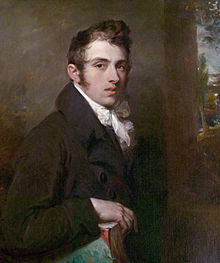William Hilton (painter)
[5] Hilton first exhibited at the Royal Academy in 1803, sending a Group of Banditti, and soon established a reputation for choice of subject and qualities of design and colour superior to the great mass of his contemporaries.[4] In 1813, having exhibited "Miranda and Ferdinand with the Logs of Wood", he was elected as an associate of the Academy, and in 1820 as a full academician; his diploma-picture representing Ganymede.In 1823, he produced "Christ crowned with Thorns", a large and important work regarded as his masterpiece, subsequently bought as the first purchase of the Chantrey Fund in 1878.[11] Some of his best-regarded pictures include "Angel releasing Peter from Prison" (life-size), painted in 1831, "Una with the Lion entering Corceca's Cave" (1832), the "Murder of the Innocents", his last exhibited work (1838), "Comus" and "Amphitrite".The Tate Gallery now owns "Edith finding the Body of Harold" (1834), "Cupid Disarmed, Rebecca and Abraham's Servant" (1829), "Nature blowing Bubbles for her Children" (1821), and "Sir Calepine rescuing Serena" (from The Faerie Queene) (1831).


The CollectionJohn ClareBritishLincolnNewarkThomas Shaftoe RobertsonSt Mary le WigfordFanny RobertsonAngles TheatreWisbechJohn Keatshistory paintingsAcademic artJohn Raphael SmithRoyal Academy SchoolsPeter De WintThomas PhillipsGanymedeChantrey FundHenry ThomsonBritish InstitutionBenjamin HaydonLincoln CathedralUna with the Lion entering Corceca's CaveAmphitriteTate GalleryThe Faerie QueeneNational Portrait GalleryVenus in Search of Cupid Surprises Dianapublic domainChisholm, HughEncyclopædia BritannicaGerald ReitlingerThe SpectatorArt UK
